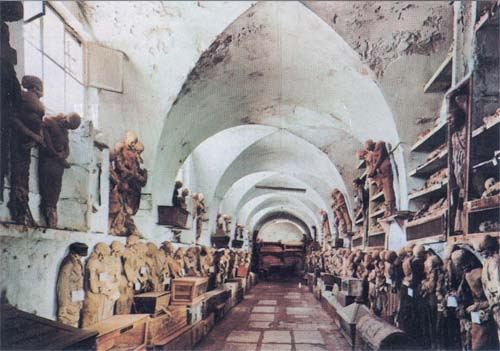
Palermo – gruesome and amazing
We rented a cab for the morning. We started out at the Catacombe dei Cappuccini, which has the mummified remains of over 800 Palermitans, including children; the last is a two year old girl in 1912. This was really eerie; the remains, sometimes with some flesh attached, are clothed and standing up or laying down, sometimes in glass cases and sometimes just on shelves. There are children and even babies mixed throughout. We saw the Capuchin Cemetary in Rome, and this one was even weirder.
We got back in the cab and went to the Palazzo dei Normanni, which has the Capella Palatina and the current seat of the regional government. It turns out that Sicily has a special arrangement with the government in Rome – they have their own Parliment and a greater amount of self-government than other parts of Italy.
The Capella Palatina has wonderful mosaics on the outer colonnade and inside. Featured are mosaics of the saints.
We had to take a tour, in Italian, of the government rooms; tours are carefully watched now. We got to see the meeting room of the parliament, which has a modern electronic voting system. We also toured the other rooms of the palace. This tour took only about 30 minutes.
We strolled over to the Chiesa di San Giovanni degli Eremiti; this is a very old church with domes from the original mosque the church is based upon.
We walked down to the Duomo. The Duomo in Palermo is a real mish-mash of architectural styles grown over time – many think its too diverse, but I think it looks cool.
We took off walking for lunch. And we walked. And walked. We asked for recommendations, and all the trattorias and restaurantes were closed! While walking, we passed four corners, the Quattro Canti, a famous intersection of two main streets in Palermo, Corso Vittorio Emanuele and Via Maqueda.
We finally had pizza at a little pizzaria at Piazza Bellini, where we got to go inside of Chiesa di Santa Maria dell’Ammiraglio (also know as Chiesa della Martorana) and Chiesa di San Cataldo (we thought they were both closed). Chiesa di San Cataldo was built between 1154 and 1160. The church has a parallelepipedal outer structure. There are no decorations inside the church, and it has a nave and two aisles. The alter, which is the original, shows a cross and the symbols of the four Evangelists. The church has a very Arabic look, as Arabic laborers built it.
The pizzeria called us a cab and we got back to the hotel to rest a bit before dinner.
Revisions:
There are no revisions for this post.



































October 3rd, 2005 by alephnaught